How to arrange heating for a private house with your own hands: diagrams for organizing an autonomous heating system
Owners of private houses know for sure that an autonomous heating system is much more economical and efficient than a centralized one.Many homeowners trust the solution to the issue of heating their homes to specialists who carry out calculations, design and supervise the arrangement of heat supply.
However, there are also craftsmen who decide to arrange the heating of a private house with their own hands, so as not to overpay for the services of specialists. But this is not a small saving from the family budget, don’t you agree?
Before proceeding with calculations and design, it is necessary to determine the optimal version of the system and its components. We will help you resolve these issues.
The article provides a detailed overview of possible engineering solutions for a private home, identifying the pros and cons of each scheme, the principles of their operation and the nuances of installation.
The content of the article:
Heating system: what are they?
There are many engineering solutions for heating a home. Let us highlight three main types of heating systems.
Heating system with liquid coolant
The most common method of heating a home in our country. Assumes the presence of a closed circuit in which circulates coolant liquid.
Water is most often used as the latter, but there can also be various antifreezes that have the advantage of having a low freezing point. To heat the coolant, a boiler of any suitable type is installed in the system.
The heated coolant is supplied through pipes to the rooms, where it enters the radiators. These devices are designed to transfer heat to air. The coolant cools down in the batteries, after which it goes through the pipes to the boiler, where it is heated again.
This cycle is repeated many times. Thermostats can be used to regulate the system, which allows you to automatically maintain the set temperature, or taps. In this case, manual regulation is performed.
Heating using coolant is a fairly simple system to design and implement. If necessary, you can assemble it yourself.But at the same time, it is certainly advisable to show the project to specialists in order to avoid mistakes that can significantly reduce the efficiency of the system.
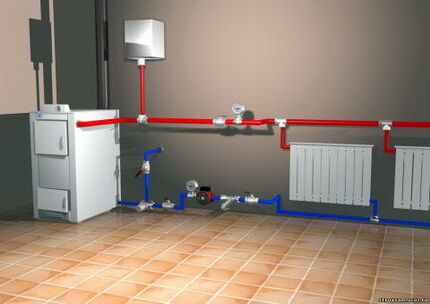
The advantages include the long service life of the structure, provided that proper installation was carried out and there are no violations in operation.
The system operates silently and is extremely easy to repair and maintain. It is important that with a correctly executed project, it is possible to maintain the required temperature in all heated rooms.
The system is efficient and saves energy resources. The energy intensity of the coolant is approximately 4000 times higher than that of air. This allows you to relatively quickly heat the air in the rooms to a comfortable temperature.
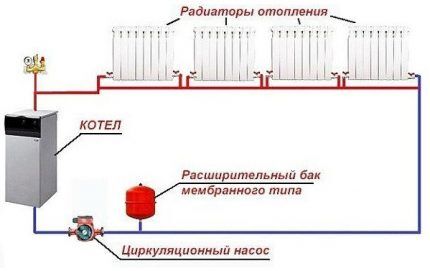
Among the disadvantages, it is worth noting that such heating can be installed only during the construction or major renovation of the house. If water is used as a coolant, it must be taken into account that its freezing point is quite high. What can lead to damage to pipes when the system freezes.
In addition, the presence of air in water pipes provokes rapid corrosion of structural elements.
Air type heating
The coolant in this case is heated air. It is heated by a water or steam heater installed in the building, as well as an electric-air or fire-air heater. After temperature treatment, the prepared gaseous environment enters the room.
According to the principle of operation, air heating circuits are divided into two types:
- combined with ventilation;
- recirculating.
The first option involves a partial admixture of a fresh portion of air captured from the street, and an equal volume release of the exhaust gas-air mass.
In the second option, all the air flow circulating around the room is captured and directed to the air heater for processing. Then it comes back in full. It is clear that in terms of sanitary and hygienic indicators, the first scheme is preferred.

Air heated to 55-60°C enters the air ducts through which it is discharged to the rooms. Here it is distributed as evenly as possible. After cooling, the air masses descend, where they pass through openings closed by a grill into the return air duct, through which they return to the heater. The cycle is repeated many times.
This heating system is regulated only through automation, which makes the temperature in the rooms extremely comfortable.
Air heating is as safe as possible, since the automation monitors all parameters of the system and blocks its elements if problems arise. In addition, the design does not contain pipes filled with hot liquid, which could burst or leak under unfavorable circumstances.
In air heating schemes there are no radiators familiar to the average person, which, coupled with the absence of pipes, significantly affects the cost of constructing the system. There are no shut-off valves required for steam and water heating types.
When constructing a circuit combined with ventilation, the issue of updating the composition of the air mass is also wisely resolved.
Service life, subject to proper care air heating installation, is about 20 years. The advantages include the external attractiveness of air heating. The plexus of pipes required for structures with a liquid coolant is absent in this case.
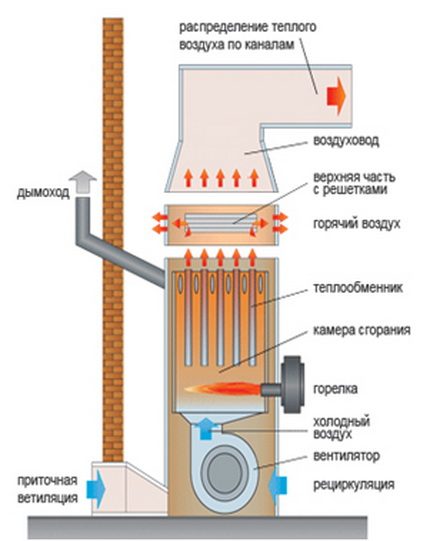
Among the disadvantages, it is worth noting possible problems with the composition of the air. The system draws in polluted air masses from the street, which requires the installation of filters. They need to be changed quite often.
In addition, it is advisable to use humidifiers, since heated masses are often overdried. If a toxic substance, such as carbon monoxide, gets into the system, it spreads very quickly throughout the house.
Electric heating systems
To install autonomous heating in a private home, systems powered by electricity are often used. There are several types, let's look at the two most popular.
Electric convectors are compact heating devices that can be installed inside a heated room. Depending on the power of the device, it can be one or several.
The operating principle of different types of electric convectors similar Cold air enters the device through the grille, where it is heated by means of an electric heating element.
Thanks to either natural convection or the efforts of a fan, heated air masses rise, mix with the air in the room, and warm it up. The room temperature rises. The cooled air descends, enters the device again and the cycle repeats.
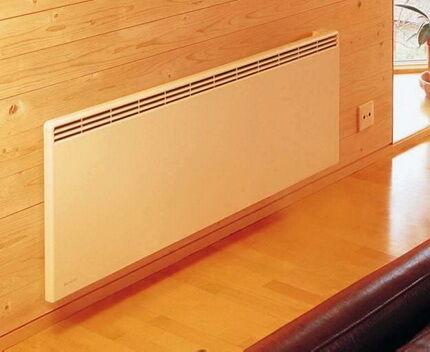
Electric heating can be realized by using infrared radiation. Thin flexible IR film is mounted on the ceiling or floor and is a kind of heating device that heats the air in the room to a comfortable temperature.
The system works as follows. When an electric current is applied to the film, the carbon elements heat up and begin to emit infrared waves in the range that is safe for humans.
These waves begin to travel to the first large object they encounter. This could be the floor, furniture or something similar. Objects accumulate infrared waves, heat up and give off heat to the air. Heating occurs very quickly.
At the same time, the distribution of heat is as favorable as possible for a person: the warmest air is in the lower part of the room, and slightly colder in the upper part.
Doctors confirm that infrared heating similar to the sun's rays and is considered the most favorable for humans. Despite the significant difference in the principle of heating operation, both types of systems have similar advantages. First of all, these are minimal construction costs.
The not very attractive tariffs of energy sales companies do not stop those who want to acquire electric heating. Automation is used to control the equipment, which allows you to configure the system to operate in the most energy-efficient mode.
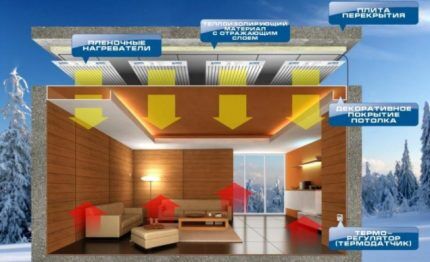
Electricity is very convenient to use. There is no need to use any fuel, which eliminates the problem of its storage and purchase.
In addition, solid fuel boilers, for example, are considered very “dirty”, since soot and ash are formed during their operation. Electrical equipment does not have these problems. It is completely safe, does not make noise and does not produce toxic emissions.
Electrical systems are usually very compact. The devices used in them can have very different designs. Such systems are durable and require only regular maintenance.
Their main disadvantage is costly operation due to the high cost of electricity. Despite the cost-effectiveness of the systems, electricity bills are usually impressive.
Types of liquid coolant systems
As practice shows, most often a system with a liquid coolant is chosen to install autonomous heating, so let’s talk about its varieties. Such a system is implemented in the form of one of two possible schemes.
The simplest scheme is one-pipe
It is a ring-shaped closed circuit, inside which heating radiators are installed in series. The coolant flows into the first of them, then into the next and so on until it returns to the boiler. This is an extremely simple scheme, however, it is far from the most effective.
Main disadvantage single pipe heating system consists in cooling the coolant at the “approaches” to the batteries farthest from the boiler.
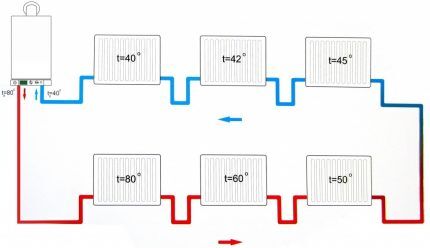
The liquid leaves the boiler heat exchanger at a temperature of about 75°C. It enters the first radiator the same way, in the second it is a little colder, and so on. If the pipeline is short and there are few radiators, then this is not a problem.
But if there are a lot of batteries, the latter will contain coolant heated to 45-50°C. Which is absolutely not enough for normal heating of the room
There may be two ways to correct the situation. The first is to increase the temperature of the coolant or add sections to the last radiators in the chain to increase their heat transfer. Both options will require additional cash investments, but do not guarantee results.
Another way to deal with the problem is to install a circulation pump. This will indeed increase the efficiency of a single-pipe system, but will also make it energy dependent and more expensive to operate.
Improved scheme - two-pipe
The main difference from the first scheme is that the coolant is supplied to each of the radiators almost simultaneously. To supply it to the device, a supply pipe is used; a pipe called a return pipe is used for collection and discharge.
The coolant can be supplied to the batteries via a collector or tee circuit. In the first case, each of the devices is supplied with its own supply and return. The pipes are laid from the collector in the form of “beams”, hence the second name “beam”.
In the tee variety, the devices are connected in series to the supply and return with the help of, assembly is carried out using connectors with three pipes - tees.
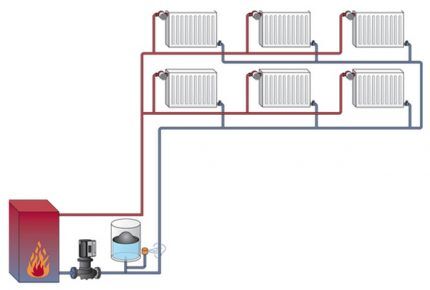
The collector involves installing shut-off valves on each outlet to the battery, which makes it possible to turn it off if necessary. Job radiant heating scheme is based on forced circulation of fluid, because for the natural movement of the coolant there are too many hydraulic obstacles in numerous rings.
Tee varieties can work both due to natural gravity and due to the inclusion of a circulation pump in the system. It pumps coolant, so when installing heating rings there is no need to maintain a slope, and the supply pipe must be installed below the heating devices.
Main advantage two-pipe scheme – ensuring uniform heating of all batteries in the building, no matter how many there are. But at the same time, its installation will require much more pipes and other elements, and accordingly, it will cost more. This is the main disadvantage of a two-pipe system.
Gravity circulation system
The coolant inside the heating circuit must move. This can occur through natural circulation. It arises due to the difference in densities that exists between the cold and heated coolant.
The heated liquid has a lower density, so it begins to spontaneously rise from the boiler along the riser, from where it is sent to the outlet pipelines and then to the radiators.As the coolant cools, its density increases, making it heavier.
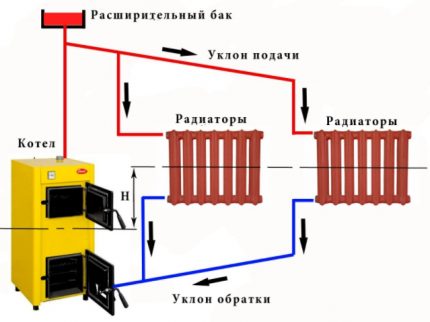
For this reason, it falls lower and is collected in the return pipeline, through which it is supplied to the boiler. Thus, while the unit is operating, gravity-type coolant circulation will be realized. However, its speed is relatively low and can vary.
Most of all it depends on two factors:
- Location of system elements. Radiators should be located significantly higher than the boiler or raised to the ceiling, or even better in the attic, the main riser from which outlets will go to the batteries.
- Temperature differences between cooled and heated coolant. The larger it is, the higher the speed of fluid movement. For this reason, the main riser can be insulated with a special material to avoid heat loss, while the return pipe, on the contrary, is not covered with anything.
The advantages of a heating system for a private house with natural circulation include its low cost and simplicity in design, arrangement and maintenance. During operation, it is absolutely silent, there is no vibration.
Disadvantages natural circulation schemes quite a bit of. It starts up slowly, which is explained by the low rate of movement of the coolant with a small temperature difference.

In addition, for normal fluid circulation in the circuit, a pipeline assembled from relatively large diameter pipes is required. Such systems are limited in size due to the low natural pressure in the line. The horizontal length of such a structure cannot exceed 30 m.
Forced circulation circuit
The system is included circulation pump, it encourages the coolant to move at a certain speed. The pump is installed anywhere in the heating line.
But to install it on the supply side, you need to buy a pump only from trusted manufacturers, because it will have to work in unfavorable conditions, although all circulation models currently produced are designed for such operation.
The pump power is selected depending on the length of the pipeline and can vary.Thanks to forced circulation, the circuit can have different lengths, up to a very long one. The rate of movement of the coolant fluid does not depend on the temperature difference, which makes it possible to implement a variety of engineering schemes.
In addition, it becomes possible to use small-diameter pipes, which has a beneficial effect on the appearance of such a heating system.

Among the shortcomings heating with pump circulation It is worth noting energy dependence. This means that if there is no power supply, the heating will not work. For places where power outages are common, this is a very serious disadvantage.
In addition, installing a pump will require additional costs for its purchase, installation and subsequent operation.
Main elements of the heating system
The set of elements included in a heating system with liquid coolant can be very different. It all depends on the type of scheme chosen. Yet a few basic elements are always present. First of all, this is the boiler. The unit generates heat, which is transferred to the coolant fluid.
According to the type of fuel used, all boilers are divided into:
- Solid fuel. All types of solid fuel are used for work: firewood, coal, peat, etc. On sale you can find varieties of such devices: pellet and pyrolysis devices.
- Gas. They operate on main natural or liquefied gas.
- Electrical. They generate heat by converting electricity.
- Liquid fuel. Diesel oil, gasoline and similar materials are used as fuel.
- Combined. The devices are equipped with several different burners and can operate with several types of fuel.
The most practical are considered combi boilers. They help not to be left without heating in conditions with interruptions in the supply of the main type of fuel. However, the cost of such models is much higher than standard ones.

Another mandatory element of the heating system is heat storage devices. They can also be different.
The following are distinguished: types of radiators:
- Panel, which are a solid steel panel of various sizes.
- Lamellar, consisting of several plates, the thickness of which can vary significantly.
- Tubular. They are made in the form of a lower and upper collector connected by pipe sections.
- Sectional. Assembled from heating sections, the number of which can be any.
And the last mandatory element of a heating system of this type is the pipeline.
Metal or plastic pipes are used to assemble it. The first ones are very durable, but are susceptible to corrosion and difficult to install. The latter are very easy to assemble, they do not rust, but the strength of different brands of plastic can vary significantly. Therefore, it is very important not to make a mistake in choosing the material for the plastic pipeline.
Conclusions and useful video on the topic
Which method of heating a private house is more profitable:
All about the one-pipe heating scheme:
Operating principle of air heating:
Autonomous heating can be arranged in a variety of ways.The choice of solution will undoubtedly be influenced by the climatic features of the area where the house is located.
It is hardly advisable to install an expensive liquid coolant system where winter lasts one or two months and the temperature rarely drops below zero. It is also important to take into account the features of the building and financial capabilities. If the right decision is made, the house will always be warm.
Do you have anything to add, or do you have any questions about organizing autonomous heating for a private home? Please leave comments on the post. The contact form is located in the lower block.




Private houses are also different. For example, we have a small one-story house, or rather, it was once an ordinary bathhouse. In winter we save ourselves with a fan heater or an electric convector; there is also a stove heating option in the house, but we have not used it for a long time. In the bathroom, the installation of heated floors under the tiles is nearing completion. It’s expensive, of course, but no more expensive than central heating.
My parents also have a small house with stove heating installed. It is unwise to use fan heaters and electric heaters; paying for electricity is too expensive. We are thinking about what kind of heating is best for a small house. Because the old stove does not heat the entire room. I want to plan everything correctly and not go bankrupt financially.
Hello Svetlana. Unfortunately, it is difficult to help you without knowing the details. In general, if the gas supply option is not considered, the easiest way is to install a solid fuel boiler with a water coolant.
The article is written clearly, thanks to the author. I am planning to design a heating system for a 2-story log house. Soon they will supply gas to the house; an extension has been built specifically for gas where the gas boiler and pipework will be located. The boiler is floor-standing (non-volatile), because there are often small (2-6 hours) power outages. I plan to install an emergency 12 volt pump into the system (if the power goes out). I don’t know what the system will look like yet, I’m still in thought and creative research on the project.
Is it just me or is there a typo/error? The heat capacity of a liquid coolant (water) cannot possibly be 4000 times greater than that of air. At no. for water it is 4.1868 kJ/kg, for air 1.005 kJ/kg.
An electric boiler is the biggest stupidity, it is cheaper to install a window sill oil radiator and do the wiring with cables than to install one boiler and do the wiring with pipes. In addition, the problem of adjusting the temperature in each room is solved and they do not freeze!